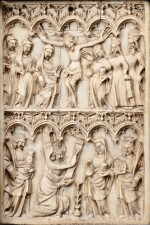Tableaux Dessins Sculptures 1300-1900
Tableaux Dessins Sculptures 1300-1900

FRENCH, MOSAN OR RHENISH, CIRCA 1360-80 | AN IVORY WRITING TABLET WITH THE CRUCIFIXION AND THE ANNUNCIATION
Auction Closed
December 3, 07:24 PM GMT
Estimate
3,000 - 5,000 EUR
Lot Details
Description
FRENCH, MOSAN OR RHENISH, CIRCA 1360-80
AN IVORY WRITING TABLET WITH THE CRUCIFIXION AND THE ANNUNCIATION
ivory
11,7 x 7,5 cm ; 4½ by 3 in.
__________________________________________________________________
FRANCE, MEUSE OU RHÉNANIE, VERS 1360-80
TABLETTE À ÉCRIRE REPRÉSENTANT LA CRUCIFIXION ET L'ANNONCIATION
ivoire
11.7 x 7.5 cm; 4½ by 3 in.
Related Literature
P. Williamson, G. Davies, Medieval Ivory Carving 1200-1550, Part I, London, 2014, pp. 368-369, cat. no. 128.
__________________________________________________________________
Référence bibliographique
P. Williamson, G. Davies, Medieval Ivory Carving 1200-1550, Part I, Londres , 2014, pp. 368-369, cat. no. 128.
This ivory writing tablet is composed of two registers of five trefoil arches resting on consoles. The lower register illustrates the Annunciation, with Mary and the Archangel Gabriel accompanied by Saint Catherine of Alexandria on the right and Saint Matthew. The upper register shows the Crucifixion, stylistically very close to a Rhenish or Mosan writing tablet, dating as ours from 1360-80, today in the Victoria and Albert Museum (inv. no. Circ.495-1923). The reverse of the ivory plaque was filled with layers of wax and could be inscribed with a stylus to use it as a writing tablet.
__________________________________________________________________
Cette tablette à écrire en ivoire est composée de deux registres de cinq arcatures trilobées reposant sur des consoles. Le registre inférieur illustre l’Annonciation où Marie et l’archange Gabriel sont accompagnés de sainte Catherine d’Alexandrie à droite et de saint Matthieu. Sur le registre supérieur est représentée la Crucifixion, très proche stylistiquement d’une tablette à écrire mosane ou rhénane, vers 1360-80, provenant de l’ancienne collection Hearn et conservée au Victoria and Albert Museum (inv. no. Circ.495-1923). Le dos de la plaquette, légèrement creusée puis remplie avec de la cire, fut utilisée comme tablette à écrire.
